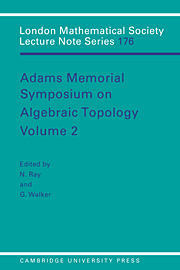Book contents
- Frontmatter
- Contents
- Preface
- Contents of Volume 1
- Programme of one-hour invited lectures
- Programme of contributed lectures
- Programme of Posters
- Participants in the Symposium
- Addresses of Contributors
- 1 Progress report on the telescope conjecture
- 2 On K*-local stable homotopy theory
- 3 Detruncating Morava K-theory
- 4 On the p-adic interpolation of stable homotopy groups
- 5 Some remarks on υ1 -periodic homotopy groups
- 6 The unstable Novikov spectral sequence for Sp(n), and the power series sinh−1(x)
- 7 Unstable Adams spectral sequence charts
- 8 On a certain localization of the stable homotopy of the space XΓ
- 9 Cooperations in elliptic homology
- 10 Completions of G-spectra at ideals of the Burnside ring
- 11 Theorems of Poisson, Euler and Bernouilli on the Adams spectral sequence
- 12 Algebras over the Steenrod algebra and finite H-spaces
- 13 The boundedness conjecture for the action of the Steenrod algebra on polynomials
- 14 Representations of the homology of BV and the Steenrod algebra I
- 15 Generic representation theory and Lannes' T-functor
- 16 Some chromatic phenomena in the homotopy of MSp
- 17 On a conjecture of Mahowald concerning bordism with singularities
- 18 Topological gravity and algebraic topology
18 - Topological gravity and algebraic topology
Published online by Cambridge University Press: 18 January 2010
- Frontmatter
- Contents
- Preface
- Contents of Volume 1
- Programme of one-hour invited lectures
- Programme of contributed lectures
- Programme of Posters
- Participants in the Symposium
- Addresses of Contributors
- 1 Progress report on the telescope conjecture
- 2 On K*-local stable homotopy theory
- 3 Detruncating Morava K-theory
- 4 On the p-adic interpolation of stable homotopy groups
- 5 Some remarks on υ1 -periodic homotopy groups
- 6 The unstable Novikov spectral sequence for Sp(n), and the power series sinh−1(x)
- 7 Unstable Adams spectral sequence charts
- 8 On a certain localization of the stable homotopy of the space XΓ
- 9 Cooperations in elliptic homology
- 10 Completions of G-spectra at ideals of the Burnside ring
- 11 Theorems of Poisson, Euler and Bernouilli on the Adams spectral sequence
- 12 Algebras over the Steenrod algebra and finite H-spaces
- 13 The boundedness conjecture for the action of the Steenrod algebra on polynomials
- 14 Representations of the homology of BV and the Steenrod algebra I
- 15 Generic representation theory and Lannes' T-functor
- 16 Some chromatic phenomena in the homotopy of MSp
- 17 On a conjecture of Mahowald concerning bordism with singularities
- 18 Topological gravity and algebraic topology
Summary
Introduction
This paper is an account, directed toward algebraic topologists, of Ed Witten's topological interpretation of some recent beakthroughs in what physicists call two-dimentional gravity; it is thus a paper about applications of algebraic topology. That algebraic topology indeed has applications was the thesis of Solomon Lefschetz's last book [20], which is an introduction to Feynman integrals. Today, the singularities which so concerned Lefschetz are avoided by string theory, which deals in a very clean and direct way with the space of moduli of Riemann surfaces; and I suspect that he would have been fascinated and delighted by the elegance of the problems which now interest mathematical physicists.
In a sense, the topic of this paper in the infinite loop-spectrum defined by Graeme Segal's category (with circles as objects, and bordered Riemann surfaces as morphisms, [2,33]); but by current standards, this is an immense object, related to the theory of Riemann surfaces as the algebraic K-spectrum is to linear algebra, and much current research is devoted to finding some aspect of this elephant susceptible to analysis by means of the investigator's favorite tool. In the present case, the subject will be the construction of topological field theories [3], using complex cobordism [1].
I first heard of these developments from a talk by Witten in the IAS topology seminar, and I learned more about them during subsequent conversations with him, with Segal, and with Peter Landweber.
- Type
- Chapter
- Information
- Adams Memorial Symposium on Algebraic Topology , pp. 291 - 308Publisher: Cambridge University PressPrint publication year: 1992



